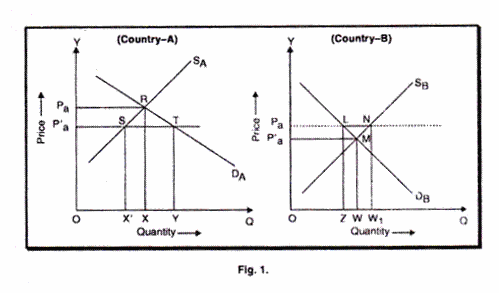The most widely employed restriction to trade is the tariff. A tariff is a charge levied on goods as they enter a country by crossing the national customs frontier, usually their general purpose is to reduce the volumes of imports.
There are two types of tariffs. Ad valorem tariffs are levied as a percentage of the total value of the commodity as it enters the country including its costs and its transportation charges-its c.i.f. value.
(The term c.i.f. stands for cost, insurance, freight, that is, the value of the commodity as it arrives at its destination, the customs frontier of the importing country).
Specific tariffs, on the other land, constitute a fixed monetary duty per unit of the imported commodity. Of the two types of tariffs the ad valorem duty is probably the more important. While both of these levies apply to imports there also exist export duties, which is placed on goods leaving a country and transit duties which are placed on goods crossing a country on the way to a destination elsewhere. Neither of these levies is very important from a quantitative point of view.
ADVERTISEMENTS:
In most cases tariffs are applied with the sole intention of reducing the volume of imports, naturally they also raise government revenues, and sometimes tariffs are applied for this purpose alone. This final category of levies on international trade is called the revenue tariff.
How do tariffs impede imports? Suppose, there are two countries A and B. Five kilograms of sugar sells for Rs. 60/- in A and for Rs. 40/- in B without international trade. Naturally if free trade prevailed, manufacturers in B would export sugar to A thus driving down the price of sugar in that country.
In order to prevent this, all country A has to do is to levy a 50 percent as valorem tariff on imports of sugar from country B. Assuming no transport costs, with the tariff the sugar produced in country B would sell in country A for exactly the same price as the domestic product. In the absence of quality differences there is no longer any reason for consumers in country A to buy sugar from country B, and imports would almost certainly cease.
This can be illustrated more generally by means of partial equilibrium supply and demand analysis as in the diagram 1. Without international trade equilibrium in country A is at point R, with quantity OX of commodity being produced and consumed at price meanwhile in country B quantity OW is being produced and consumed at price Pb.
ADVERTISEMENTS:
With international trade, an equilibrium price Pa1= Pb1 prevails in both countries. At that price country B produces a surplus ZW1 which it exports to country A where it exactly equals the shortage X1Y prevailing there at the new price. The volume of trade thus is X1Y or ZW1.
If country A now wishes to prevent all imports, it need simply impose a tariff in the amount Pa1 – Pd. This will raise the price of imports to Pa; domestic supply will expand from S to R, domestic quantity demanded will contract from T to R, and all imports will be shut out. In the exporting country the demand for its exports is eliminated, price falls, and supply contracts from N to M while domestic quantity demanded expands from L to M. Hence in the absence of transport costs a tariff equal to the difference between the domestic pre trade and post trade price has the effect of eliminating trade between the two countries. With transport costs, a somewhat lower tariff will have the same effect. A less restrictive tariff less then
Pa1-Pa reduce the volume of trade by a smaller amount and thus will not eliminate it entirely.
ADVERTISEMENTS:
Tariffs are imposed for a variety of reasons each one demanding the reduction of imports, such as the following:
(i) A tariff may be designed to redistribute income from one group of citizens to another.
(ii) Its purpose may be to stimulate domestic employment or at least to slow a general decline in the level of domestic employment.
(iii) It may be intended purely for the purpose of collecting government revenues.
(iv) Its purpose may be to improve the country’s balance of trade and hence its balance of payments with the rest of the world.
(v) A tariff may be designed to improve the terms of trade thus securing for the country a larger share of the gains from international trade and specialization.
(vi) It may merely be intended to restrict consumption of certain commodities which the government deems harmful to society or to the economy.
(vii) Its purpose may be simply to protect domestic industries from foreign competition in order to allow them to reach a level of productive efficiency that is consistent with competitive firms in the international market place.
(viii) The motive may be for support certain segments of the economy that are sufficiently important to merit it either militarily, economically or politically.
ADVERTISEMENTS:
A tariff does each of these things automatically no matter what is its primary intension.
